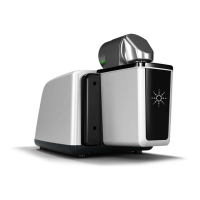Analyzing Samples
Agilent Cary 630 FTIR Spectrometer User’s Guide 37
In the case of a volatile sample, larger amounts of sample can be
applied without concern of leakage or damage to the instrument.
However, using the smallest amount of sample possible will ease
in the cleaning process.
CAUTION
The Ge ATR accessory windows or metal mounting plate can be damaged by
extreme samples. Only measure samples with a pH between 1 and 14. Do not
leave extremely acidic or basic samples on the metal mounting plate for an
extended time.
CAUTION
Although Ge is a hard material, the ATR window can crack under extreme
pressure conditions. Ensure that the sample makes contact with the entire
surface area of the crystal and not just a point within the crystal. Avoid using the
sample press on samples that may be sharp or pointed.
If the sample is a liquid or paste, the sample press does not need to be
used at all. In this case, you can proceed with the analysis.
If the sample is a powder or solid, the sample press must be in contact
with the sample. To make contact, rotate the sample press knob in a
clockwise direction until the pressure arm no longer goes down. A
spring mechanism keeps pressure on the sample; take care not to over
tighten the clamp. Once the pressure arm stops moving, apply no more
than ¼ turn of the sample knob.
4 For instructions on collecting a sample spectrum using the
software, refer to the Agilent MicroLab PC Software User’s Guide.
5 After completing the sample measurement, immediately clean the
sample from the accessory using the instructions provided on
Page 36. It is important to make sure both the Ge sampling
window and the sample press tip are free of any residue from the
previous sample.
For instructions on reviewing results and handling sample data, refer
to the Agilent MicroLab PC Software User’s Guide.

